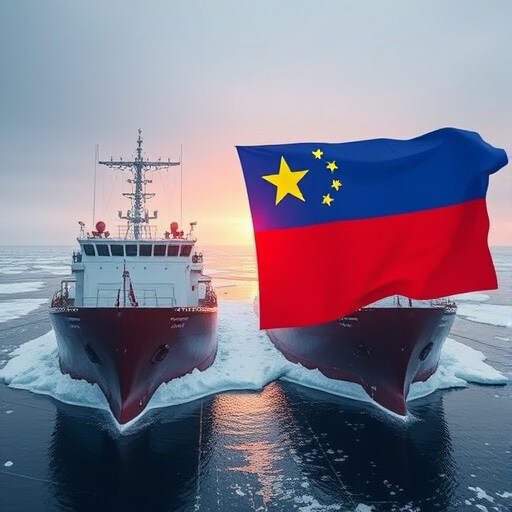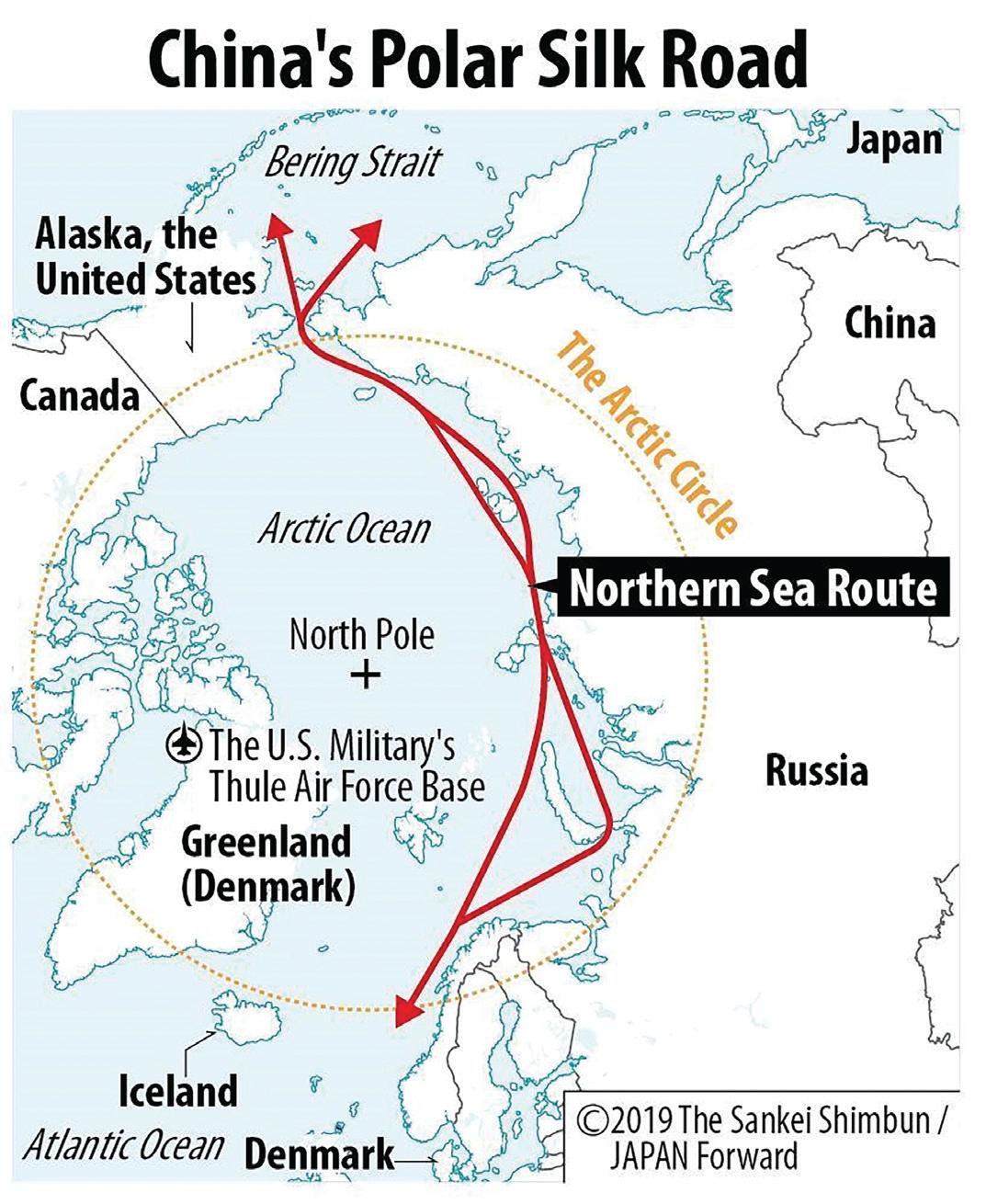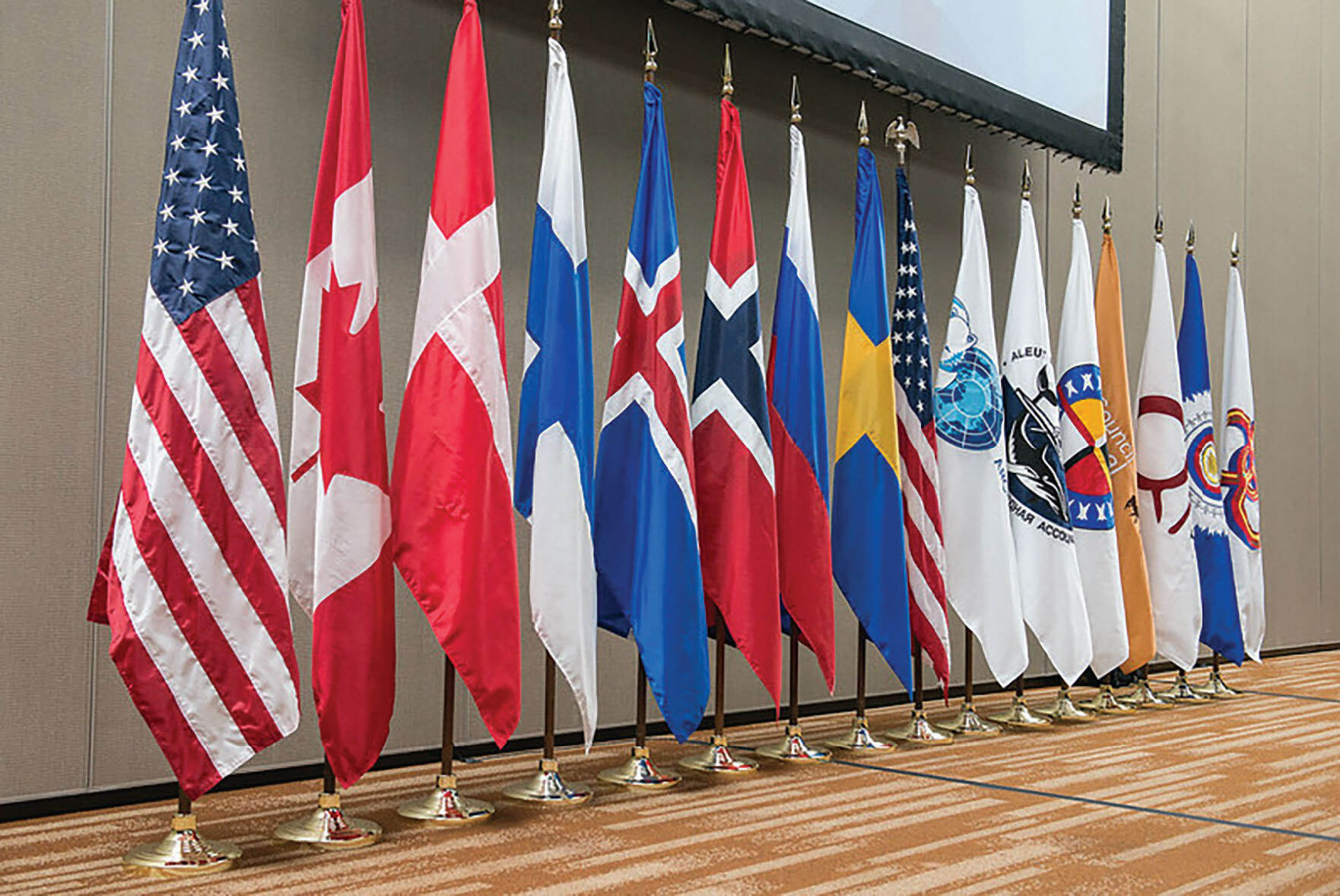Winter 2024
Oceans Apart – Arctic Frontiers of the Great Game
Seventeen years ago, a pair of submersible vessels descended more than two miles beneath the glacial ice cap to deposit a Russian flag on the seabed at the North Pole. This highly symbolic dive under the Lemonosov Ridge was designed to magnify President Vladimir Putin’s disputed claim to almost half of the Arctic Ocean, and its potential for oil, gas, and other resources.
Inside the first of the mini submarines – Mir‑1 and Mir‑2 – were two members of Russia’s State Duma, the first of whom, Artur Chilingarov, resurfaced after more than eight hours to declare that their mission was a reminder to the world of Russia’s prominence as a “great Arctic and scientific power”. A personal call of thanks from Putin merely reinforced the significance of this statement to the Kremlin. Russia’s Foreign Minister, Sergey Lavrov, gave a more public utterance. “The goal of this expedition is not to stake out Russia’s rights, but to prove that our shelf stretches to the North Pole,” he said.
Eight countries; Canada, Denmark, Finland, Iceland, Norway, Sweden, Russia and the United States each have Arctic coastlines that under international convention have rights to economic zones within 200 miles of their shores. At the time, Canada was the first to register immediate disapproval of the Russian expedition. “This isn’t the 15th century,” then Canadian foreign minister Peter MacKay said. “You can’t go around the world and just plant flags and say, ‘We’re claiming this territory’”.
The Russian declaration now appears less wild in the context of Putin’s expansionist aggression in Ukraine. The underwater odyssey nevertheless serves as a clear reminder of how our planet’s seas have become key geopolitical and strategic bellwethers.
Oceans are home to 94 percent of all life on Earth, and an increasingly important economic and national security resource – 90 percent of global goods trade is shipped via sea routes, but many of the world’s busiest maritime transit corridors are at risk of geopolitical disruption.
Submarine cable systems carry more than 99 percent of intercontinental communication traffic, invisible enablers of global connectivity that nonetheless have the potential for interference. And that is without considering the environmental costs of climate change and the plight of indigenous people whose lives rely upon sustainable seas.
International attention in past decades tended to focus on maritime crime: piracy, illicit fishing, illegal migration, and drugs trafficking. But the trend is rather different today with regional waterways serving as spaces of power projection where state and non-state actors assert control and coercion short of war.
China’s grey zone operations in the South China Sea and Iran’s harassment of oil tankers in the Strait of Hormuz since 2017 are merely two examples. Both challenge international law, cause insecurity, and disrupt international trade.
The planet’s seas have become key geopolitical bellwethers
Al-Shabaab, in both its terrorist Somali and militant Mozambican guises, uses the maritime domain for illicit operations to promote economic and political agendas. The Iranian-backed Houthi militia has been fighting for power in Yemen for years and has raised the level of violence to unprecedented heights by attacking merchant vessels in the Red Sea since November 2023.
Such threats and risks are unlikely to diminish as geopolitics, geoeconomics, and even the weaponisation of vital areas like trade and energy, are increasingly applied in the context of foreign policy. The Danish Institute for International Studies defines the high seas as “legally neutral spaces” where strong political, economic and cultural messaging can be created through violent means but without infringing any state’s sovereignty – “a relatively low risk-high gain effort short of war”.
This has several implications, including a hardening of threat patterns at sea compared to those witnessed in the past. That these now involve not merely criminal organisations but also political and state actors, risks a weakening of existing platforms for international cooperation and the fragmentation of any robust solutions to promote maritime security. This has left a dangerous vacuum in which maritime domains and their resources can be further claimed by criminals, political groups and states.
Which brings us back to Russia and the Arctic. The past decade of Russian aggression has spawned many water-borne consequences, not least those affecting maritime routes around the Black Sea and the questionable hybrid assault on the Nord Stream pipelines in the Baltic. But Putin has always viewed the Arctic as the ultimate prize.
Moscow’s aggression has provoked strong reactions from bodies that govern international waters. In 2023, the International Maritime Organisation voted Russia off the UN body’s executive board. Similarly, following the invasion of Ukraine, the Arctic Council, the sole body addressing issues faced by the Arctic governments, declared that its members would not attend council meetings under Russian chairmanship. The same countries later said they would resume cooperation on a limited number of previously approved Arctic Council projects that do not involve Russian leadership or participation, in effect freezing collaboration over the Arctic’s future.

Source: AI generated
Western sanctions, seemingly powerless in other areas, have to an extent curbed Putin’s dreams of a gas El Dorado in the Gulf of Ura in Russia’s far north where Novatek, Russia’s largest privately-owned gas company, has been establishing two facilities to liquefy natural gas and dispatch it globally. Prior to Ukraine, Putin’s vision was for Russia to become the foremost producer of LNG worldwide. But sanctions have tempered production and hindered the transfer of gas carrier vessels from South Korea aimed at LNG transport from Novatek’s Yamal and Arctic 2 facilities. In fact, Geoffrey Pyatt, President Joe Biden’s Assistant Secretary of State for Energy Resources, is said to have been almost messianic in his wish to “kill Russian LNG”.
In the grand power play of the oceans, however, the Russian president has other plans also. He wants to further develop the Northern Sea Route (NSR), a maritime passage through the Arctic to connect the Pacific and Atlantic Oceans. The steady reduction in sea ice is opening new opportunities for trade. The NSR could potentially slash the time it takes to travel between Asia and the West by as much as 20 days, with Arctic sea- lanes becoming the 21st-century equivalent of the Suez and Panama canals. The freeze in the Arctic Council’s dialogue has allowed Russia to usher in other actors.
For India and particularly China, whose continued purchase of Russian oil and fuel exports has kept the Russian economy afloat throughout the Ukraine conflict, the NSR provides serious opportunity. It offers potential access, not merely to the Arctic’s oil and gas deposits but also other untapped assets including uranium, rare earth minerals, gold and diamonds. Both countries will be able to develop the NSR on Russia’s coasts and provide further ice-breaking ships without which short term usage of the passage will be untenable – though with the effects of climate change some estimate it may be ice-free by as early as 2030.
In July 2024, it was reported that Sibir, a Russian nuclear-powered icebreaker was escorting the light ice- class vessel Xin Xin Hai 1 on its voyage from the Port of Taicang near Shanghai via the Bering Strait and the NSR to the Port of Arkhangelsk before travelling on toward ports in northern Europe. The New Shipping Line of Hainan Yangpu, which owns several ice-class vessels, completed seven transits between July 2023 and December 2023, and in June 2024 signed an agreement with Rosatom, the all-powerful Russian state corporation to establish a year-round arctic shipping route.
Australia, with a strong interest in the High North, is among several countries that are watching this deepening Sino-Russian Arctic cooperation with considerable concern. Since Moscow’s invasion of Ukraine, NATO’s northward expansion and the build-up of Russian military presence in the region, some in Canberra offer apocalyptic predictions of the consequences of an Arctic Great Game in which China is playing an ever-more assertive role.

Source: The Sankei Shimbun / JAPAN Forward
None of this, of course, has evaded Washington. During Donald Trump’s first tenure in the White House, little was made of the melting ice cap or the climate change questions with which others were chiefly engaged.
Trump’s focus was firmly on economic and security issues. And while he did not necessarily favour Russian activity in the Arctic, the dealmaker in Trump saw himself – rightly or wrongly – as someone who could negotiate with Putin and come to some arrangement with Russia that would benefit US interests as much as those of the Kremlin.
By contrast, Trump has always seen China as the far greater threat in terms of security and trade. And if anyone was unsure about his position or may have
thought his only interest in the Arctic related to the economics of the deep, his previous Secretary of State – and former CIA Director – Mike Pompeo gave a clear view of Trump’s thinking about China’s Arctic ambitions. In a speech outside the formal proceedings of the Arctic
Council in Rovaniemi, Finland, in 2019, Pompeo ridiculed China for claiming it was a Near-Arctic State though the shortest distance between China and the Arctic was 900 miles. China, he said, merely had observer status in the Arctic Council.
Putin has always viewed the Arctic as the ultimate prize

Source: Arctic Council Secretariat/Linnea Nordström
That Beijing had announced plans to connect the North Sea Route with China’s Maritime Silk Road was part of “a very familiar pattern”.
“Beijing attempts to develop critical infrastructure using Chinese money, Chinese companies and Chinese workers,” said Pompeo. “In some cases, to establish a permanent Chinese security presence.”
He talked of dire warnings from the Pentagon that China could use its civilian research presence in the Arctic to strengthen its military presence, including the deployment of submarines to the region as a deterrent against nuclear attack.
“Do we want the Arctic Ocean to transform into a new South China Sea, fraught with militarisation and competing territorial claims,” he said.
That message is certain to resonate with those tasked to promote a second Trump presidency. Marco Rubio, his candidate for Secretary of State and one of Beijing’s fiercest opponents, has for many years been highly critical of America’s inability to commission new icebreakers for the Arctic. Although President Biden in 2024 announced an Icebreaker Collaboration Effort, or ICE Pact, with Canada and Finland to produce such
vessels, none is likely to be built fast enough to compete with either China, or Russia. Rubio’s congressional pressure on the Commandant of the US Coast Guard to ensure America’s has the tools it needs to combat Chinese incursion into the Atlantic and the Arctic will not diminish after January 2025.
Rubio is among a number who believe that the United States has for too long viewed China as a pan-regional power that challenges US primacy in the Pacific and Indian Ocean basin but ignores the Atlantic and the Arctic. “Beijing and the People’s Liberation Army have ambition to establish an Atlantic presence, “says Michael Rubin, a senior fellow at the American Enterprise Institute, the Washington-based conservative think tank.
And what of Trump 2.0 and its oceanic dynamic with China and Russia? Much has been made of the new President’s belief that he can end the war in Ukraine within days of taking office. Whether true or not, he will see any peace settlement as part of a global deal to promote American interests. In the case of the Arctic, some suggest that Trump will come to some kind of arrangement with Putin.
While he may want to maintain the public impression of continuing to harm Russia’s LNG ambitions, behind the scenes he could potentially ease US sanctions on Russian Arctic LNG – though not of course to the detriment of America’s own exports. We are told that he believes “through the power of the deal” he will be able to find a means to control the wider ambitions of his Russian counterpart.
But beyond that Trump will also want to find a mechanism to reduce Chinese influence in the High North. And that may prove difficult for a man who has tended to shun serious engagement with international organisations, and in fact plans to place tariffs on those that could assist in this cause. Ultimately only Russia can curb China’s Arctic ambitions, in which case Trump must find a way to lure Putin away from his new-found Chinese allies, and that is most likely to involve some territorial concession. In which case that Russian flag planted on the icy ocean floor so many years ago may prove to be more than just a symbolic gesture.
Tom Rhodes is Chief Operating Officer of Montrose Associates and a former Washington Correspondent for The Times